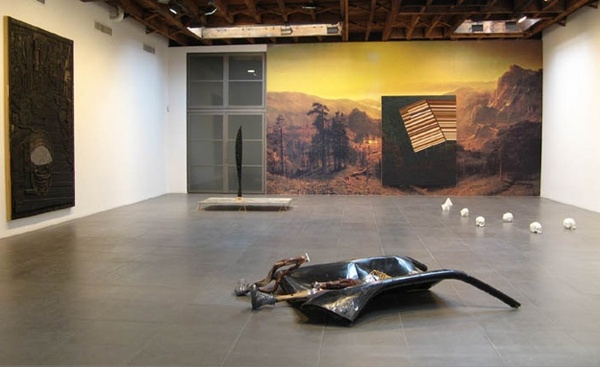This is an archive of the ArtCat Zine, 2007-2009. Please visit our new project, IDIOM.
Death, Creation, and Dymaxion Dynamics
Terranaut
Matthew Day Jackson
Peter Blum Gallery, Chelsea - 526 West 29th Street, New York NY
12 September - 8 November 2008
Matthew Day Jackson's exhibition at the Peter Blum Gallery's Chelsea location resists palpable interpretation. Titled Terranaut, the melange of thematically related sculpture and paintings instills a conflated unease, a sense of simultaneous death and birth. One exits trying to remember the difference, his conceptions of finality and creation faltering.
Jackson works with found objects and recontextualized materials. Dead or discarded things -- tree branches, roots, car parts, old cloth -- are reborn as symbols of death. Dymaxion Skeleton, set off by itself in dim alcove, borrows Buckminster Fuller's design for a sculpture of a Dymaxion skull propped up by a skeleton of lithe wooden debris, lit from the floor of a close-fitting, coffin-size box with three mirrors on each interior wall. The whole effect is similar to a skeletal model used for demonstrations in anatomy lectures, using the discoveries from death to display the workings of life -- all in order to, of course, prevent death and prolong life.
The main gallery holds the bulk of the show, and each work feeds off the others in an extension of the principle behind found object contextualization. Skulls and skeletons feature prominently in several places, as do astronomical figures. The space conveys the sense of some aftermath to a catastrophic event. Another found skeleton -- this time skull-less -- lies atop the dented roof of a car. A thick wooden plank pins the neck of a dangling spacesuit constructed from surplus army blankets. One sculpture is simply a sheet of dented metal, painted and placed to seem part of the gallery wall. Jackson seems fascinated with lingering impacts. Vestiges of destruction are reborn in their representation.
A smaller gallery houses three large scale reworkings of Goya's Disasters of War series, rendered in vivid neon paint over carefully laid fragments of charred wood. The scorched background fits the tone of the original nineteenth century sketches, while brightly highlighted figures leap out from the ash in striking contrast. Here Jackson seems conscious of time's relentless progression in spite of individual suffering, past atrocity, through acts brave or cruel. These reimaginings transcend Goya's efforts at graphic realism, creating life through the use of color and suggestion of movement in the positioning of wood pieces out of the death and violence depicted long ago.
As living and thinking increasingly adapt to the incessant blast of information blaring at our senses, artists like Jackson have developed an effective ability to isolate particular parts of the cacophony and arrange them in newly expressive combinations. Choosing symbols of decay and death, he has created sculptures suggestive of a world greater than the human condition, but of which humanity is still nonetheless a significant part. Jackson seems to have an awareness of the world as objects with meaning in context of the events that have collided them into other objects, and explores the implication of these ever changing, ever recombining symbols in relation to one another. In an era when possibility seems on the verge of exhaustion and hope shrinks, Terranuat looks not to new discoveries for inspiration, but rather connections between that which is already known.
ZINE
HOME
TIPS / COMMENTS
CATEGORIES
CONTRIBUTORS
- Greg Afinogenov
- B. Blagojevic
- Adda Birnir
- Susannah Edelbaum
- Julie Fishkin
- Paddy Johnson
- Jessica Loudis
- Christopher Reiger
- Andrew Robinson
- Peter J. Russo
- Blythe Sheldon
- S.C.Squibb
- Hrag Vartanian

